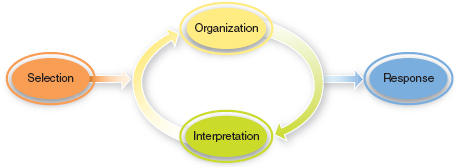3.1 PERCEPTION AS A PROCESS
Printed Page 75
Perception as a Process
Perception helps us understand our world
In the movie Inception, Dom Cobb—played by Leonardo DiCaprio—is a master at extraction, the art of entering others’ unconscious minds while they’re asleep and stealing their thoughts. Since living inside others’ dreams can lead one to confuse dream states with reality, Cobb has a “totem” that he keeps with him always, a simple tool that allows him to tell quickly whether he’s dreaming or awake. Cobb’s totem is a top: when he is within a dream state, it will spin smoothly and endlessly, whereas when he is awake, it will spin for a few moments, then wobble and fall.

Like Dom Cobb, each of us has a totem we trust to tell us what’s real and what isn’t: our perception. Perception is the process of selecting, organizing, and interpreting information from our senses. We rely on perception constantly to make sense of everything and everyone in our environment. Perception begins when we select information on which to focus our attention. We then organize the information into an understandable pattern inside our minds and interpret its meaning. Each activity influences the other: our mental organization of information shapes how we interpret it, and our interpretation of information influences how we mentally organize it. (See Figure 3.1 below.) Let’s take a closer look at the perception process.
